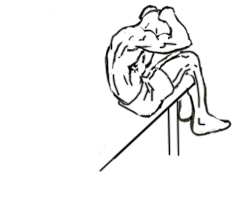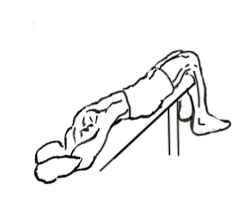Last Updated on October 3, 2023
When it comes to building a strong, defined core, few exercises are as effective as the decline abdominal crunch. This exercise targets all your abdominal muscles, helping you develop a well-rounded, strong core. If you’re looking for an exercise that isolates your abs while providing a controlled, safe movement, decline crunches are perfect for you. In this comprehensive guide, we’ll break down the benefits, proper technique, common mistakes, and variations of the decline abdominal crunch. Let’s dive in!
What Is a Decline Abdominal Crunch?
A decline abdominal crunch is an advanced version of the standard crunch, performed on a decline bench. The incline angle of the bench adds resistance, increasing the challenge and allowing you to better target your core muscles. By using a decline bench, your legs are kept steady, which isolates the abdominal muscles more effectively, offering a more intense workout than standard crunches.
The decline crunch primarily focuses on the rectus abdominis (the “six-pack” muscle) but also engages the obliques and transverse abdominis, making it a great overall core workout. If you’re aiming to enhance your core strength or develop defined abs, this exercise should be in your routine.
Muscles Worked in Decline Abdominal Crunches
The decline abdominal crunch is a core-focused exercise that targets multiple muscle groups:
- Rectus Abdominis: The primary muscle worked during the crunch, responsible for the six-pack look.
- Obliques: The muscles along the sides of your abdomen that help with twisting movements.
- Transverse Abdominis: A deep muscle that acts like a natural weight belt, stabilizing the core.
- Hip Flexors: While the goal is to isolate the abs, the hip flexors will also engage during the decline crunch due to the position of your legs.
Benefits of Decline Abdominal Crunches
Adding decline abdominal crunches to your workout routine offers several benefits:
- Increased Core Activation: The decline angle adds difficulty, engaging the core muscles more effectively than flat bench or floor crunches.
- Stronger Abs: By isolating the abdominal muscles, decline crunches help build both strength and endurance in the core.
- Improved Posture: Strengthening your core can improve your posture, as a strong core supports the spine and reduces slouching.
- Enhanced Athletic Performance: A strong core is essential for sports and physical activities, helping with balance, stability, and power in movements.
- Efficient Fat Burning: Core exercises like decline crunches can help tone the muscles, which can contribute to a more defined appearance when combined with proper nutrition and overall fat loss.
Proper Technique for Decline Abdominal Crunches
To get the most out of decline abdominal crunches, proper form is crucial. Follow these steps to perform the exercise correctly:
- Set up the decline bench: Position a decline bench at an appropriate angle, usually between 30 to 45 degrees. Sit on the bench and place your feet under the foot pads to secure them.
- Lie down and position your hands: Lie back with your feet firmly planted under the pads. Place your hands either across your chest or gently on either side of your head (around your ears). Be sure not to pull your neck with your hands—this can lead to strain or injury.
- Engage your core: Before you begin the movement, brace your core by tightening your abdominal muscles. This helps prevent unnecessary strain on your lower back.
- Perform the crunch: Slowly lift your upper body toward your knees by engaging your abdominal muscles. Focus on using your abs to lift your body rather than swinging or using momentum. Your lower back should stay in contact with the bench throughout the movement.
- Pause and squeeze: At the top of the movement, pause and squeeze your abdominal muscles for a second. This maximizes muscle engagement and increases the effectiveness of the exercise.
- Lower back down slowly: After the pause, slowly lower your upper body back to the starting position, keeping your abs engaged to control the descent. Use the full range of motion for the best results.
- Repeat: Perform the desired number of repetitions, typically 3 sets of 10 to 15 reps, depending on your fitness level.
Common Mistakes to Avoid
To ensure you’re maximizing the benefits of decline abdominal crunches and minimizing the risk of injury, avoid these common mistakes:
- Using momentum: One of the biggest errors is relying on momentum to lift the upper body rather than focusing on core engagement. Avoid jerking or swinging during the movement—slow and controlled is key.
- Pulling on the neck: Placing your hands behind your head may cause you to pull on your neck, which can lead to discomfort or strain. Instead, place your hands lightly near your ears or across your chest.
- Overarching the lower back: To prevent lower back strain, ensure that your lower back remains in contact with the bench during the exercise.
- Shortening the range of motion: For optimal results, use the full range of motion. Lower your upper body all the way down and lift it fully up to engage all the abdominal muscles.
- Neglecting proper breathing: Inhale as you lower your body and exhale as you crunch up. Proper breathing helps engage your core more effectively and maintain control throughout the movement.
Variations of Decline Abdominal Crunches
Once you’ve mastered the basic decline crunch, you can add variety to your workout by incorporating different variations that target other parts of your core or increase the difficulty.
- Weighted Decline Crunch: Hold a weight plate or a dumbbell across your chest to increase resistance. This added weight will make the crunch more challenging and engage your muscles even more.
- Twisting Decline Crunch: As you rise up during the crunch, rotate your torso to one side, bringing your opposite elbow toward your knee. This movement engages your oblique muscles, adding an extra challenge to the exercise.
- Decline Leg Raise: Instead of performing a crunch, lie back on the bench and lift your legs toward the ceiling. This exercise targets the lower abs and complements the decline crunch for a full-core workout.
- Reverse Decline Crunch: In this variation, you lift your legs instead of your upper body. Lie on the decline bench with your legs straight and perform a reverse crunch by lifting your hips off the bench. This move targets the lower abs.
- Bicycle Decline Crunch: Combine the twisting crunch with a cycling leg movement to work both your upper and lower abs while also engaging your obliques. Bring one knee toward your opposite elbow, alternating sides as you perform the movement.
How to Incorporate Decline Abdominal Crunches into Your Workout Routine
To maximize the benefits of decline abdominal crunches, it’s important to know how to fit them into your regular workout routine. Here are some tips:
- Frequency: Include decline crunches in your core or full-body workout routine 2 to 3 times a week. Give your muscles enough time to recover between sessions.
- Reps and sets: Aim for 3 to 4 sets of 10 to 15 reps for each variation you perform. As you get stronger, you can increase the resistance or the number of reps.
- Pair with complementary exercises: Decline abdominal crunches are great for isolating your core, but you can pair them with other core exercises like planks, leg raises, or Russian twists to create a comprehensive core workout.
Are Decline Abdominal Crunches Right for You?
Decline crunches are an advanced abdominal exercise, so if you’re a beginner, it’s important to build a foundation of core strength before attempting this exercise. Start with basic crunches or planks to strengthen your core, then gradually introduce decline crunches into your routine as you become more comfortable.
However, if you already have a solid foundation of core strength, decline crunches are an excellent way to push your abs to the next level. Just remember to maintain proper form and start with manageable sets and reps.
The decline abdominal crunch is a powerful and effective exercise for anyone looking to build a stronger, more defined core. By performing this exercise correctly and incorporating it into your workout routine, you can target all areas of your abs, improve your posture, and enhance your overall athletic performance. Whether you’re a seasoned athlete or someone who’s just looking to strengthen your core, the decline crunch can help you reach your fitness goals.








